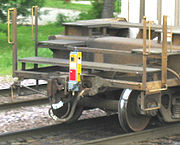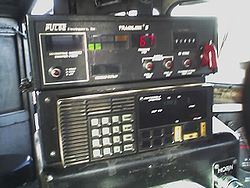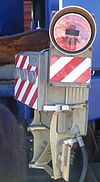
Flashing rear-end device
Encyclopedia

Caboose
A caboose is a manned North American rail transport vehicle coupled at the end of a freight train. Although cabooses were once used on nearly every freight train, their use has declined and they are seldom seen on trains, except on locals and smaller railroads.-Function:The caboose provided the...
. They are divided into two categories: 'dumb' units which only provide a visible indication of the rear of the train with a flashing red taillight; and 'smart' units which also send back data to the crew in the locomotive
Locomotive
A locomotive is a railway vehicle that provides the motive power for a train. The word originates from the Latin loco – "from a place", ablative of locus, "place" + Medieval Latin motivus, "causing motion", and is a shortened form of the term locomotive engine, first used in the early 19th...
via telemetry
Telemetry
Telemetry is a technology that allows measurements to be made at a distance, usually via radio wave transmission and reception of the information. The word is derived from Greek roots: tele = remote, and metron = measure...
. They originated in North America, and are used elsewhere in the world.
Design and use
The 'smart' FRED devices monitor functions such as brake lineAir brake (rail)
An air brake is a conveyance braking system actuated by compressed air. Modern trains rely upon a fail-safe air brake system that is based upon a design patented by George Westinghouse on March 5, 1872. The Westinghouse Air Brake Company was subsequently organized to manufacture and sell...
pressure and accidental separation of the train using a motion sensor, functions that were previously monitored by a crew in the caboose. The FRED transmits the data via a telemetry
Telemetry
Telemetry is a technology that allows measurements to be made at a distance, usually via radio wave transmission and reception of the information. The word is derived from Greek roots: tele = remote, and metron = measure...
link to the Head-of-Train Device (HTD) in the locomotive, known colloquially among railroaders as a 'Wilma'. This is a play on the first name of the wife of cartoon character Fred Flintstone
Fred Flintstone
Frederick Joseph “Fred” Flintstone, also known as Fred W. Flintstone or Frederick J. Flintstone, is the protagonist of the animated sitcom The Flintstones, which aired during prime-time on ABC during the original series' run from 1960-66. He is the husband of Wilma Flintstone and father of Pebbles...
. In Canada, this device is known as an SBU (Sense and Braking Unit).
A typical HTD contains several lights indicating telemetry status and rear end movement, along with a digital readout of the brake pipe pressure from the FRED. It also contains a toggle switch used to initiate an emergency brake application from the rear end. In modern locomotives, the HTD is built into the locomotive's computer system, and the data is displayed on the engineer's computer screen.
Railroads have strict government-approved air brake testing procedures for various circumstances when asembling trains or switching out cars en route. After a cut is made between cars in a train and the train is rejoined, in addition to other tests, the crew must verify that the brakes apply and release on the rear car (to ensure that all of the brake hoses are connected and the angle cocks, or valves, are opened). In most cases, the engineer is able to use data from the FRED to verify that the air pressure reduces and increases at the rear of the train accordingly, indicating that proper brake pipe continuity. This device is said to constitute a fail-safe
Fail-safe
A fail-safe or fail-secure device is one that, in the event of failure, responds in a way that will cause no harm, or at least a minimum of harm, to other devices or danger to personnel....
condition.
The FRED reduced labor costs, as well as the costs of the purchase and upkeep of cabooses. The Brotherhood of Conductors, and Brotherhood of Railroad Brakemen were also greatly affected by FRED, as this electronic unit replaced two crewmen per train. The widespread use of FREDs has made the caboose nearly obsolete. Some roads still use cabooses where the train must be backed up, on short local runs, as rolling railroad police
Railroad police
Railroad police are different from one country to another. Their roles in some countries are not different from that of any other police agency in others they are more related to a type of security police. They are all commonly responsible for the protection of railroad vast networks of...
stations and transportation for right-of-way
Right-of-way (railroad)
A right-of-way is a strip of land that is granted, through an easement or other mechanism, for transportation purposes, such as for a trail, driveway, rail line or highway. A right-of-way is reserved for the purposes of maintenance or expansion of existing services with the right-of-way...
maintenance crews.
Evolution


Florida East Coast Railway
The Florida East Coast Railway is a Class II railroad operating in the U.S. state of Florida; in the past, it has been a Class I railroad.Built primarily in the last quarter of the 19th century and the first decade of the 20th century, the FEC was a project of Standard Oil principal Henry Morrison...
in 1969, soon other Class I railroad
Class I railroad
A Class I railroad in the United States and Mexico, or a Class I rail carrier in Canada, is a large freight railroad company, as classified based on operating revenue.Smaller railroads are classified as Class II and Class III...
s began using FREDs as well, until the mid 1980s when they were common equipment. Early models were little more than a brake line connection, battery and flashing tail light. As their use became more widespread through the 1980s, FREDs were equipped with radio transmitters to send brake pressure data to a receiver in the locomotive. To reduce the cost of battery replacements, ambient light sensors were added so the flashing light on the FRED would illuminate only after dark. Later models have a small turbine-powered electrical generator using air pressure from the brake line to power the FRED's radio and sensors.
The one-way communication of brake data from the FRED to the locomotive evolved into two-way communication that enables the engineer to apply the brakes from both ends of the train simultaneously in an emergency. This is useful in the event that a blockage in the train's brake pipe is preventing all of the cars in the train from going into an emergency application. Such a situation could be dangerous, as stopping distance increases with fewer functional brakes. Dumping the brake pipe pressure from both the front and rear of the train ensures that the entire train applies its brakes in emergency. Other electronics within the FRED were also enhanced, and many now include GPS
Global Positioning System
The Global Positioning System is a space-based global navigation satellite system that provides location and time information in all weather, anywhere on or near the Earth, where there is an unobstructed line of sight to four or more GPS satellites...
receivers as well as the two-way radio communications.
Railfan usage
RailfanRailfan
A railfan or rail buff , railway enthusiast or railway buff , or trainspotter , is a person interested in a recreational capacity in rail transport...
s and railway photographers sometimes monitor FREDs as early warning systems to detect approaching trains. FREDs in North America operate on the 452.9375/457.9375 MHz frequency pair with the exception of those operated by Norfolk Southern Railway
Norfolk Southern Railway
The Norfolk Southern Railway is a Class I railroad in the United States, owned by the Norfolk Southern Corporation. With headquarters in Norfolk, Virginia, the company operates 21,500 route miles in 22 eastern states, the District of Columbia and the province of Ontario, Canada...
, which uses AAR
Association of American Railroads
The Association of American Railroads is an industry trade group representing primarily the major freight railroads of North America . Amtrak and some regional commuter railroads are also members...
channel 67 (161.115 MHz). Railfans often program these frequencies into their radio scanners, which can provide a handy indicator of train activity (usually 2–5 miles, transmitting at 2 watts).
Other countries
In AustraliaAustralia
Australia , officially the Commonwealth of Australia, is a country in the Southern Hemisphere comprising the mainland of the Australian continent, the island of Tasmania, and numerous smaller islands in the Indian and Pacific Oceans. It is the world's sixth-largest country by total area...
a number of safeworking
Safeworking
Signalling block systems enable the safe and efficient operation of railways, so as to avoid collisions between trains. Block systems are used to control trains between stations and yards, and not normally within them. Any block system is defined by its associated physical equipment and by the...
systems require end-of-train devices on trains. They vary from simple flashing lights with no air brake connection, to complete End of Train Air System (ETAS) or Sense and Brake Unit (SBU) devices.

